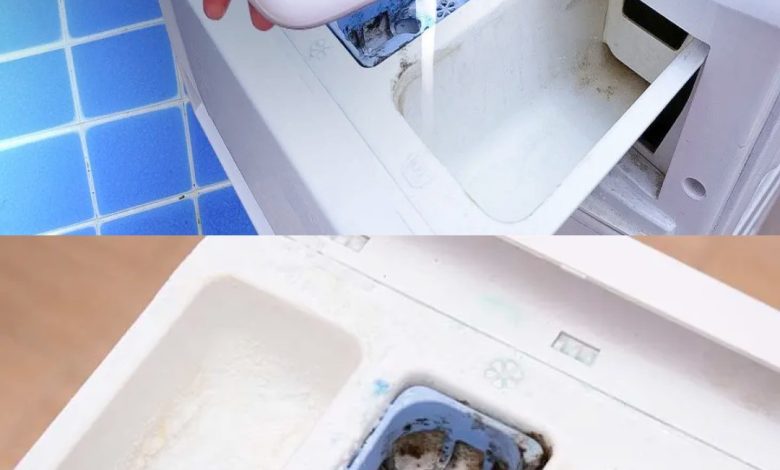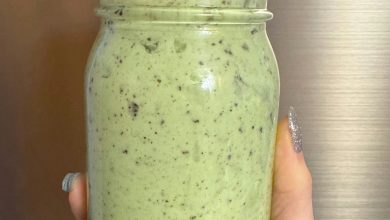The genius trick to clean the washing machine drawer: like new it will be rid of mold

Cleaning the washing machine drawer might seem like a minor task, but as recent social media videos have shown, it’s something that many people overlook until it’s too late. A viral video featuring a young woman discovering that her washing machine drawer is detachable has sparked a flurry of comments and reactions, highlighting just how dirty and moldy this compartment can become if not properly maintained.
ADVERTISEMENT
In the video, the woman expresses her shock at realizing that the drawer could be removed entirely, revealing a horrifying sight: layers of filth and mold that had accumulated behind it. This discovery has prompted many others to check their own washing machine drawers, leading to the realization that regular cleaning of this often-neglected part of the machine is crucial.
ADVERTISEMENT
The Hidden Dangers Lurking in Your Washing Machine Drawer
The washing machine drawer is designed to hold detergents, fabric softeners, and other cleaning agents. However, due to its constant exposure to moisture and chemicals, it can become a breeding ground for mold, mildew, and bacteria. These contaminants can then transfer to your clothes during the wash cycle, leading to unpleasant odors and potential health risks.
ADVERTISEMENT
One user commented on the video, sharing their own experience of cleaning the drawer by soaking it in hot, soapy water before using a stronger cleaning solution to scrub away the grime. Another user mentioned that they had also only recently learned that the drawer could be removed, and after a thorough cleaning with boiling water and dishwashing liquid, their drawer was spotless.
Step-by-Step Guide to Cleaning Your Washing Machine Drawer
If you’re ready to tackle the dirt and mold lurking in your washing machine drawer, here’s a detailed guide to help you through the process:
- Remove the Drawer: Most washing machine drawers are designed to be removable for easy cleaning. Look for a small button or lever that releases the drawer. Gently pull it out, taking care not to spill any remaining detergent or softener.
- Soak the Drawer: Fill a basin or sink with hot water and add a generous amount of dishwashing liquid or laundry detergent. Submerge the drawer in the soapy water and let it soak for at least 30 minutes. This will help to loosen any built-up grime and residues.
- Scrub Away the Dirt: After soaking, use an old toothbrush or a small brush to scrub away the dirt and mold. Pay special attention to the corners and crevices where mold tends to accumulate. If needed, you can use a stronger cleaning solution, such as a mixture of vinegar and baking soda, to tackle stubborn stains.
- Rinse and Dry: Once the drawer is clean, rinse it thoroughly with warm water to remove any soap or cleaning solution residues. Wipe it dry with a clean cloth or let it air dry completely before reinserting it into the washing machine.
- Clean the Compartment: While the drawer is drying, take a moment to clean the compartment where the drawer sits. Use a cloth or sponge soaked in a mixture of water and white vinegar to wipe away any dirt or mold that may have accumulated inside the machine.
- Reinsert the Drawer: Once everything is clean and dry, reinsert the drawer into the washing machine, making sure it clicks securely into place.
Maintaining a Clean Washing Machine Drawer
To prevent mold and grime from building up in the future, it’s important to clean your washing machine drawer regularly. Here are some tips to keep it in top condition:
- Weekly Cleaning: Make it a habit to clean the drawer at least once a week, especially if you use liquid detergents or fabric softeners, which can leave behind sticky residues.
- Use the Self-Cleaning Function: If your washing machine has a self-cleaning function, activate it regularly to keep the drum and drawer free from bacteria and mold. However, be aware that this feature may not always be sufficient on its own.
- Leave the Door Open: After each wash cycle, leave the washing machine door open to allow air to circulate and prevent moisture buildup. This will help to reduce the chances of mold growth inside the drum and drawer.
- Wipe the Door Seal: The rubber seal around the door is another area where moisture can accumulate, leading to unpleasant odors. After every wash, wipe the seal dry with a clean cloth to prevent mold from forming.
Dealing with Persistent Odors
If your washing machine has developed a musty smell that persists even after cleaning the drawer, it may be time to give the entire machine a deep clean. Here’s how:
- Run an Empty Cycle with Vinegar: Pour 1 liter of white vinegar directly into the drum and run an empty wash cycle at 90°C. This will help to disinfect the machine and remove any lingering bacteria or mold.
- Clean the Drum and Seal: After the vinegar cycle, wipe down the drum, door seal, and porthole with a cloth soaked in white vinegar. This will remove any remaining residues and freshen up the machine.
- Dry the Drum: After every wash, leave the door open to allow the drum to dry completely. This simple step can go a long way in preventing mold and odors.
Cleaning your washing machine drawer may not be the most glamorous household chore, but it’s essential for maintaining a hygienic and efficient machine. By following the steps outlined above and incorporating regular cleaning into your routine, you can ensure that your washing machine drawer stays mold-free and your laundry smells fresh every time.




